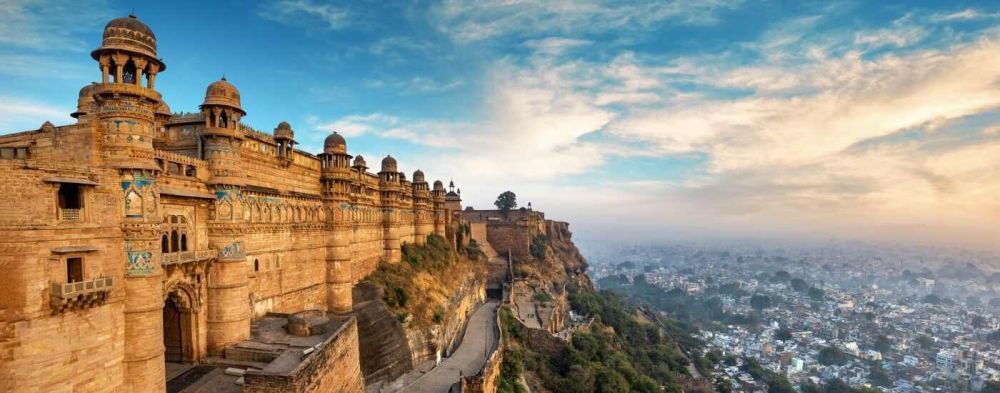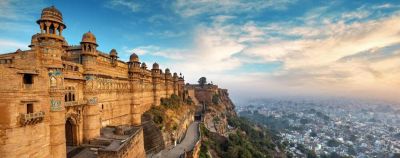

The Khajuraho Group of Monuments is a group of Hindu and Jain temples in Madhya Pradesh, India, about 175 kilometers southeast of Jhansi. They are one of the UNESCO World Heritage Sites in India. The temples are famous for their nagara-style architectural symbolism and their erotic sculptures. Built between 950 and 1050 by the Chandela dynasty, these temples present aesthetics and artistry of Indian culture. A visit to these temples not only offers a cultural insight but also a dive into ancient Indian architecture. The light and sound show in the evenings adds an additional layer to the experience, narrating the temples' history and legends.
Situated within the foothills of the Vindhyan Mountains, the Bhimbetka rock shelters exhibit the earliest traces of human life in India, some of which are approximately 100,000 years old. It's an archaeological site spanning the prehistoric Paleolithic and Mesolithic periods, and also the historic period. These rock shelters showcase incredible cave paintings that are reminiscent of the beginning of human life and pre-historic times. The natural red and white pigments give insights into the lives of the inhabitants depicting hunting, dancing, music, and animals. It's a fascinating peek into history, art, and anthropology, making it another UNESCO World Heritage site worth visiting.
The Upper Lake or Bhojtal is a large waterbody in the heart of Bhopal, Madhya Pradesh. Often referred to as the 'City of Lakes,' Bhopal's Upper Lake is said to have been constructed by King Bhoj during his reign. Visitors can enjoy a serene boat ride, taking in the scenic beauty of the lake with the cityscape on the horizon. This activity is perfect for families, couples, and solo travelers looking to escape the hustle and bustle of city life. One can indulge in various water sports available here, such as paddle boating, rowing, and motorboat riding while enjoying the splendid views of the sunset.
Kanha National Park, also known as Kanha Tiger Reserve, is one of the largest national parks in India and the perfect place for nature and wildlife enthusiasts to witness the majesty of the tiger in its natural habitat. The park's lush sal and bamboo forests, grassy meadows and ravines provided inspiration to Rudyard Kipling for his famous novel 'The Jungle Book'. Visitors can book a safari for an adventurous exploration of the park's rich flora and fauna, where they might spot tigers, leopards, wild dogs, barasingha and more. The park also conducts a night safari, adding a thrilling dimension to the wildlife spotting experience.
Gwalior Fort is not only an architectural marvel but also a stronghold with a history that is intertwined with the very fabric of Indian history. Situated on an isolated rock outcrop, the imposing fort overlooks the city of Gwalior and has been the battleground for many significant wars. With a blend of Muslim and Hindu architectural influences, the fort houses several historic buildings including mansions, temples, and water tanks. The intricate carvings and the light and sound show in the evenings make it a captivating site for tourists. Walking through the fort gives one a spectacular view of the city while being engulfed by stories of valor, love, and betrayal that echo from its walls.
The Sanchi Stupa is one of the oldest stone structures in India, built by the emperor Ashoka the Great in the 3rd century BCE. It is located in the small village of Sanchi in Raisen District. The stupa is a marvel of Buddhist art and architecture and has been designated as a World Heritage Site by UNESCO. The site features intricate carvings that depict various events of Lord Buddha's life. Visitors can explore the peaceful grounds and soak in the spiritual and historical significance of the stupa, the four ornate gateways facing four directions, and the surrounding monasteries and temples which contribute to the sanctity of the place.
The Kumbh Mela in Ujjain is a massive Hindu pilgrimage and festival, which is held every 12 years in the city of Ujjain in Madhya Pradesh. It is a spectacle of faith where millions of devotees gather to bathe in the sacred river Shipra to cleanse their souls of sins and achieve salvation. The Kumbh Mela is not only a spiritual journey but also a cultural experience where one can witness the diversity of Indian traditions, rituals, and practices. Numerous sadhus (holy men) from different sects attend the festival along with people from across the globe, offering an incredible sight and a powerful experience of unified faith and fervor.
The ancient city of Mandu, perched atop a 20 square kilometer plateau in the Dhar district, is a testament to love and architectural genius. Often referred to as the 'City of Joy,' Mandu was once the fortress city of the Malwa rulers. Visitors can explore a number of remarkably well-preserved ruins, which include palaces like the Jahaz and Hindola Mahals, Hoshang Shah's tomb, and the iconic Jahaz Mahal that sits between two artificial lakes. The allure of Mandu is in its romantic ambiance, legendary tales of the poet-prince Baz Bahadur and his beautiful consort, Rani Rupmati, and the blending of Afghan and Mughal architecture.
Orchha, set on the banks of the Betwa River, is a quaint town that whispers tales of the Bundela dynasty that once ruled it. The Orchha Fort complex contains grand structures such as the Jehangir Mahal, Raj Mahal, and Rai Praveen Mahal. Each of these historic buildings boasts striking architecture with delicate chhatris and intricately carved murals. Apart from the fort complex, tourists are drawn to the numerous cenotaphs that line the river and the Ram Raja Temple which is the only temple where Lord Rama is worshipped as a king. Orchha is an enchanting location that offers a slice of history preserved, away from the chaos of city life.
The Dhuandhar Falls is located at Bhedaghat in Jabalpur and is one of the most majestic waterfalls in India. Dhuandhar literally means 'smoke flow,' and one can see why it is so called when they witness the mist created by water droplets as the Narmada River makes its powerful descent. The water cascades down from a height of about 30 meters creating a visually stunning scene. Visitors can take a cable car ride to get a panoramic view of the falls or embark on a boat ride on the river to experience the falls up close. Trekking around the falls and the marble rocks of Bhedaghat provides a thrilling adventure combined with enchanting views.
